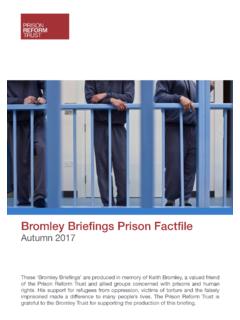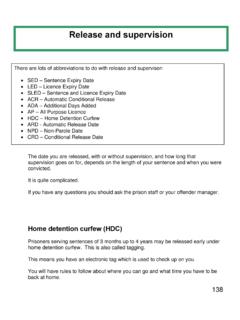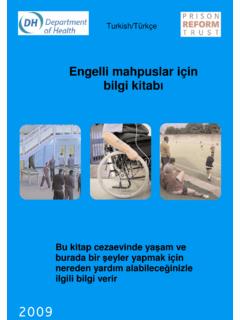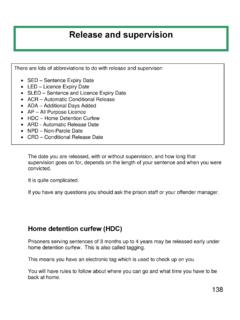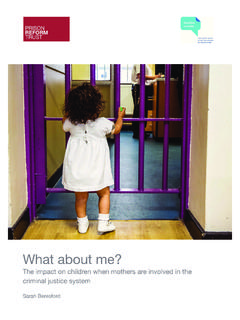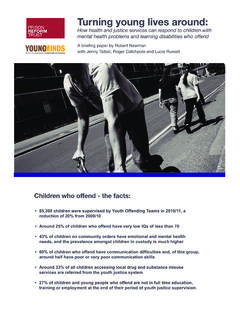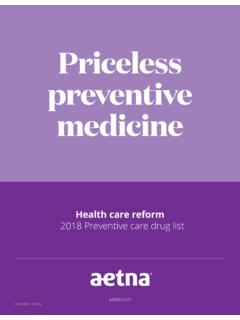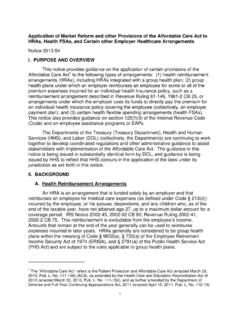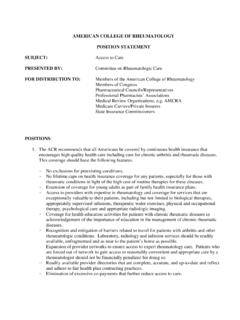Transcription of In Care, Out of Trouble - prisonreformtrust.org.uk
1 In care , Out of TroubleHow the life chances of children in care can be transformed by protecting them from unnecessaryinvolvement in the criminal justice system An independent review chaired by Lord Laming Prison Reform Trust image: Locked in Rainbows, Atkinson Secure Unit (Secure Children's Home), Pierce Brunt HighlyCommended Award for Drawing (Koestler Trust)ISBN: 978-1-908504-92-0 Printed by: Conquest LithoForeword1 Summary of findings and recommendations51. Strong and determined leadership at national and local level72. Early support for children and families at risk93. Good parenting by the state104. Responding to looked after children in minority groups145.
2 Prevention, diversion and rehabilitation186. Supporting young people leaving care20 Appendix One: Concordat on protecting looked after children from criminalisation - guiding principles21 Appendix Two: 23 Review members23 About the review24 Key facts26 Good practice examples28 Endnotes30 Acknowledgments32 ContentsForeword Since July 2013 I have been to 16 schools and I have been in 15 different placements all around the country .. All of my offending has been whilst in review panel member, aged 15 years, 25 June 20151 These children are in our care ; we, the state, are their parents and what are we setting themup dole, the streets, an early grave?
3 I tell you: this shames our country and we willput it Rt. Hon. David Cameron MP, Prime Minister, October 20152 This review was established to examine the reasons for, and how best to tackle, the overrepresentation of children in care , or with experience of care , in the criminal justice system inEngland and to reduce the disproportionate number of young people who are, or have been, inpublic care progressing into custody is laudable. The over representation of looked afterchildren in the youth justice system has to be challenged and changed. But it soon becomesdistressingly clear that starting at the point of evidence of criminal behaviour is for manyyoung people simply too late in the day.
4 Remedial work and rehabilitation are essential butprevention is so much more rewarding and fruitful for the young person and wider society. Itis against that background that it would be good to pause and reflect again on theimportance of childhood in the social and emotional development of every young parenting entails a lifetime commitment. It creates the solid foundation on which is builtthe evolving unique personality that, hopefully, will in due course become the fulfilled essential ingredients are security, stability, unselfish love and an unyielding commitmentto give the child the best start and hope for the future.
5 It is in this context that young childrendevelop self confidence, trust, personal and social values and optimism. Loss, neglect ortrauma at this early stage in life often result in profound and enduring consequences. Great emphasis should be placed on early life experiences. Guidance and support throughpregnancy and during the early months of parenthood should be available to all who need are clear long term benefits in identifying problems at an early stage rather thandelaying until a crisis. It is in all of our interests that as many children as possible are enabledto grow up to become successful, law abiding and fulfilled citizens well able to be good rolemodels for the next generation.
6 We all have a part to play in this, but especially the widerfamily. At times of difficulty steps should be taken to involve other family members andencourage their different contributions and support. Handled in the right way a crisis might beshort-lived and stability restored. After all, this is a well trodden path in many families withoutthe assistance of the state. This can be hugely satisfying work for frontline staff. Working inthis way in some local authorities has already resulted in fewer children coming into in childhood is more than a nice thing to do. It has a real value that goes beyond thechild as it facilitates the future wellbeing of society.
7 Failure to help the child and, where possible, tosupport the family at this stage is both costly to the child and very expensive to the state. In everyway the price is high for everyone involved. In financial terms it costs over 200,000 each year tokeep a young person in a secure children s home and the yearly cost of a place in a youngoffender institution is about 60, many young people in custodial institutions demonstrates all too clearly the gaps in theirsocial development and in their basic education. It is impossible not to be moved by theirexperiences and the serious constraints on their life chances. For some, their anger, frustrations,inability to express themselves except through challenging behaviour and possibly violence allpoint to failure, for whatever reason, in their earlier years.
8 Yet with the right help at the right time,the capacity of many children to change and their resilience in difficult circumstances is staff in these establishments need to be equipped to demonstrate a mixture of soundprofessional skills and impressive personal qualities. They deserve good training, propersupervision and support. We should honour what they do on behalf of us all not least because fewof us, including me, would choose to take on such challenging and at times distressing work can be tough, demanding and at times dispiriting. But this review has heard howgood practice can achieve inspiring is abundantly clear is that no one service operating alone can hope to meet the needs ofthese young people or their families.
9 Each one of the key public services has a distinct and clearresponsibility in law to fulfil the duties placed upon them by the United Kingdom Parliament andthe Welsh Assembly. One of those duties is to work in partnership with each of the other the years there have been far too many well publicised examples of services failing to workacross organisational boundaries both in the exchange of information and in day by day practicein the protection and support of vulnerable children. We have seen and heard of excellent jointworking and co-located teams in places such as Leeds and Surrey to divert looked after childrenfrom unnecessary criminalisation.
10 Good practice is achieving splendid results in other areas is the time to make it standard practice everywhere. Surely the time has come when it should be made clear that the performance of the most seniorofficers, and their tenure, should be judged against the quality and effectiveness of the work forchildren, not least in the success of the good collaboration between different services. This is notto imply that senior managers can know each child in public care . But they must be expected tohave put in place robust and effective quality standards and fail-safe mechanisms so that apossible service failure and drift are identified and corrected speedily.

